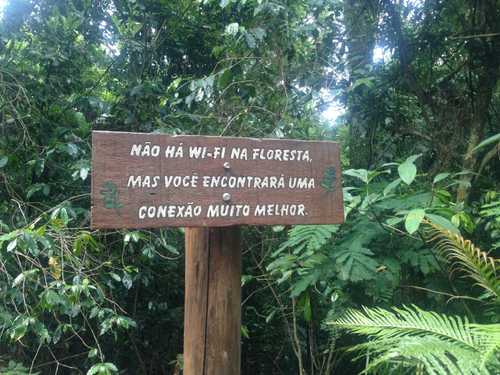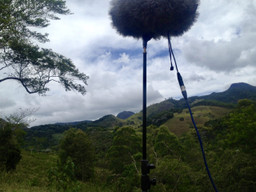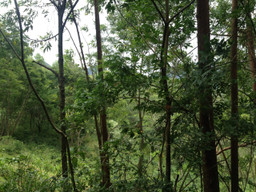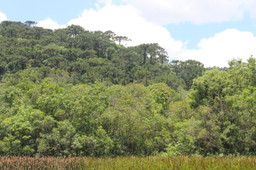
How I came to record in the Atlantic Forest
“The Atlantic Forest domain stretches from the northeastern to the southern regions of Brazil and northern Argentina and southeastern Paraguay. In the northeastern part of Brazil it occupies a thin coastal strip not exceeding 40 miles in width, while in the south it extends from the coast to as far as 200 miles [322 km] inland. […] It harbors around 2,200 species of birds, mammals, reptiles and amphibians—5% of the vertebrates on Earth. This includes nearly 200 bird species found nowhere else.” – The Nature Conservancy.
According to the Brazilian Institute of Forests, 39% of the mammals that inhabit the Atlantic Forest are endemic. The Golden lion tamarin is emblematic of this biome but unfortunately it is in great risk of extinction. Regarding the flora, it is estimated that an impressive number of 8000 species are endemic to the Atlantic Forest. In fact, it holds the world record number of tree species by hectare – 454 in the south of Bahia!

For me, listening to and recording forest soundscapes switched on a unique fascination, and the desire to understand and listen more. I started to become highly curious when browsing sound recordings of Estonian ponds and Bornean cicadas. Once I decided to explore this field further, I made up my mind to visit Brazil.
As well as being an impressively large country, with many geographic opportunities to record, I was fortunate enough to have close friends living in São Paulo and Rio de Janeiro and family members in the state of Rio Grande do Sul who kindly opened their houses to me. These are strong anchors, especially when it comes to safety and moving around the country.
Being a guest can be a very different experience than visiting as a tourist, especially as tourism raises complex issues that can hurt local populations, despite governmental and institutional advertisement that this sector is an economic necessity.
I was able to spend 10 weeks in total in Brazil and during this period I went from getting access and support from the staff of a state park in São Paulo to spending three weeks in the middle of the forest in the state of Minas Gerais, living in a research center alongside other volunteers, conducting my own informal work at my own pace.

This was my first field recording trip, and my first trip outside Europe, made with an immeasurable need to escape the darkness and gloom of the Swedish winter. I confess that my planning was not brilliant, but ultimately I was lucky enough that everything went well. Also, meeting certain fundamentals allowed me to move around smoothly.
Planning essentials
- Budgeting for travel and accommodation, for access to areas of interest, and for emergencies
- Ability to communicate with local people
- Knowing people or having friends or relatives able to help with housing and travel, and advise on cultural norms and bureaucracy
- Understanding of basics like the location and schedules of hospitals, clinics, and embassies
- Having at least the beginnings of a plan of what to record
- Considering smaller details in advance, such as how and where to find transport schedules and buy tickets
- 4G cover, SIM cards, etc.
How I approached organizations
About two months prior to arriving, I emailed the local authorities responsible for the state parks and protected areas near my main temporary residence. I briefly introduced myself, explained my interest in recording within their area, and proposed to share the recordings with them.
Shortly after arriving in São Paulo, I called to schedule a meeting. I was thrilled to be welcomed by the nicest, friendliest people. They seemed to have a genuine interest in this work and were curious about why I had chosen to do it. They were not working in this role by chance, either: from biologists with a deep interest in and love for the more-than-human-world, to administrative and managerial staff deeply concerned about the privatization of national parks, pollution, people’s disconnection from the forest’s flora and fauna, and the multitude of perils – from poverty and social exclusion to political corruption – which lead to poaching and the encroachment of illegally constructed houses into the forest.
These factors alerted me to the intersectionality of social and environmental justice. It was then that I understood that one can’t live without the other and they always have been profoundly tied. That being said, I don’t believe it’s possible to work in a well-rounded way when social and political factors are ignored; this will likely do a disservice to a place and its people.

I asked for information about how the park administration’s biologists and other experts carry out their work everyday, and whether I could get to know them. First, I made an informal visit to the main area of the park – one of the four of what they call ‘nucleus’ – to experience it and have specific questions or topics to discuss.
Meeting the administrative staff a few days later, I shared my experiences with them, having already become enchanted by that magic world. When the cicadas were singing loudly, I thought I was on another planet, so I asked when they are most active – so you can see how little I knew! (Fortunately, trail signage indicated the location of different species of monkeys and venomous animals.) It’s extremely important to learn how to remain safe in the park, so the rangers briefed me on the basics.
Although I believe that this is now starting to change, some people and organizations don’t understand the importance of documenting the sounds of a natural system. But it shouldn’t take much to incite their curiosity: I found that by sharing with them the visualization of the sound via a spectrogram offers a point of connection from something people can relate (visual cues) to a new idea or concept (the recorded sound itself).
A predetermined plan can show that you are a sufficiently organized person. In both places I visited – in the states of São Paulo and Minas Gerais -, I asked whether it could be important or helpful to record a particular situation. For example, a bird that is difficult to see, or an area that’s changing – for better or for worse.
📌 So: be friendly, study a bit in advance if possible, but stay humble as you are a guest. Ask how you can be helpful and whether there are particular species or areas to focus on, be curious and share your sounds.
Local people
Local people can be incredibly helpful on this kind of sound quest. In the rural area where I’m currently living, which has a very low population density, pretty much everyone knows each other. Some people who have lived here for quite a while know all the unmarked trails, where to listen to a specific animal, when it’s best to listen to a particular bird, recognise animal tracks, or know about their behaviors. People with this level of knowledge will also be aware of the landscape (and soundscape) changes which are so valuable for this work.
📌 So, make a point of meeting people and talk to them about their surroundings. And remember that it’s not only about their practical knowledge, but about how they listen. One can certainly expect a different awareness of sound from a semi-hermit in a forested valley, compared to a businessman in a suit living in a city!
Where was I in Brazil?
The first area I worked in was the Parque Estadual da Cantareira. I was made very welcome in this state park, and with some coordination could do almost everything I wanted. When I chose to record in this public space, I visited during the scheduled opening times. However, on a few occasions, the staff were generous enough to open the gates for me much earlier than the regular schedule, allowing me to record the solitary tinamou, which I have been in love with ever since. Since I had brought along an artist friend, we also did some photography, painting, and documentation.

Subsequently, I proposed to do more of the same as part of a paid volunteer program at the Iracambi Research Center, and was swiftly accepted. I fully recommend this type of model, as I was able to live in the middle of the forest in the Center’s accommodation, recording when and what I want, leaving my gear outside for the whole night without worrying much about theft, hiking, and feeling very free during my time here.
When choosing to work and collaborate with organizations of this kind, I’d recommend checking thoroughly that they don’t damage local economies, whether they are involved in political initiatives, and what kind of conservation models they adhere to. Environmental justice can’t exist without social justice, so it is fundamentally important to be aware of the connections we are establishing and supporting.
Reciprocity
Financing these trips only became possible when I was around 30 years old. I was so grateful for the stability this gave me, and for being welcomed so warmly, that I donate 15% to 50% of the revenue of album sales of Mata Atlântica and Nocturnal Sounds of the Atlantic Forest to the NGOs that helped me and which continue to promote sustainable development, grow new forests, promote education and lobby against mining in the region. 🌱
Photos courtesy of Melissa Pons
Earth.fm is a completely free streaming service of 1000+ nature sounds from around the world, offering natural soundscapes and guided meditations for people who wish to listen to nature, relax, and become more connected. Launched in 2022, Earth.fm is a non-profit and a 1% for the Planet Environmental Partner.
Check out our recordings of nature ambience from sound recordists and artists spanning the globe, our thematic playlists of immersive soundscapes and our Wind Is the Original Radio podcast.
You can join the Earth.fm family by signing up for our newsletter of weekly inspiration for your precious ears, or become a member to enjoy the extra Earth.fm features and goodies and support us on our mission.
Subscription fees contribute to growing our library of authentic nature sounds, research into topics like noise pollution and the connection between nature and mental wellbeing, as well as funding grants that support emerging nature sound recordists from underprivileged communities.
